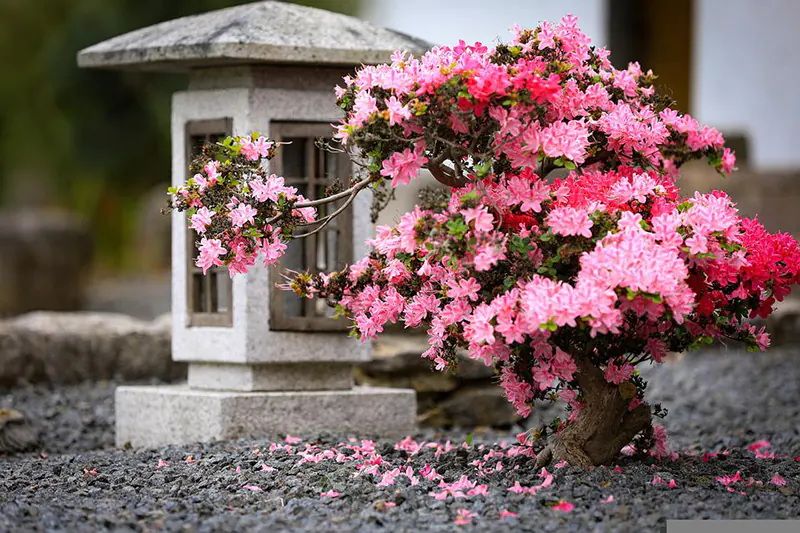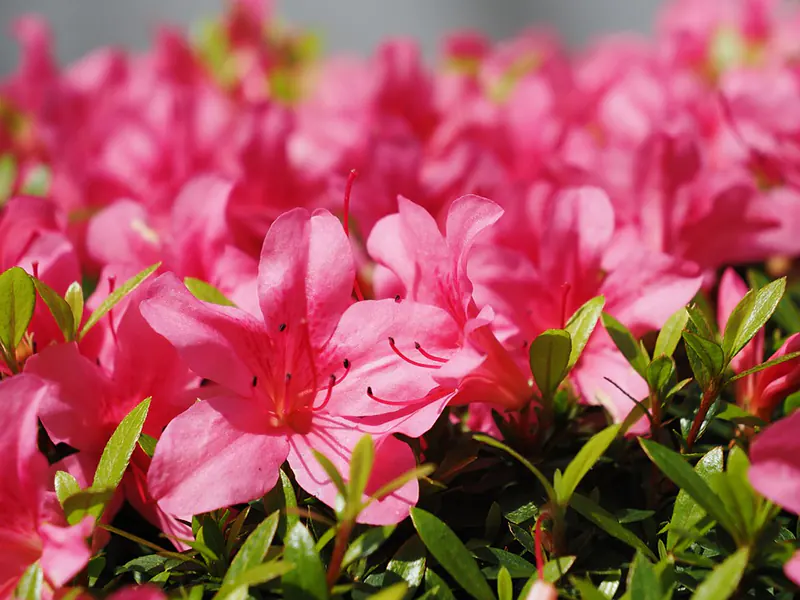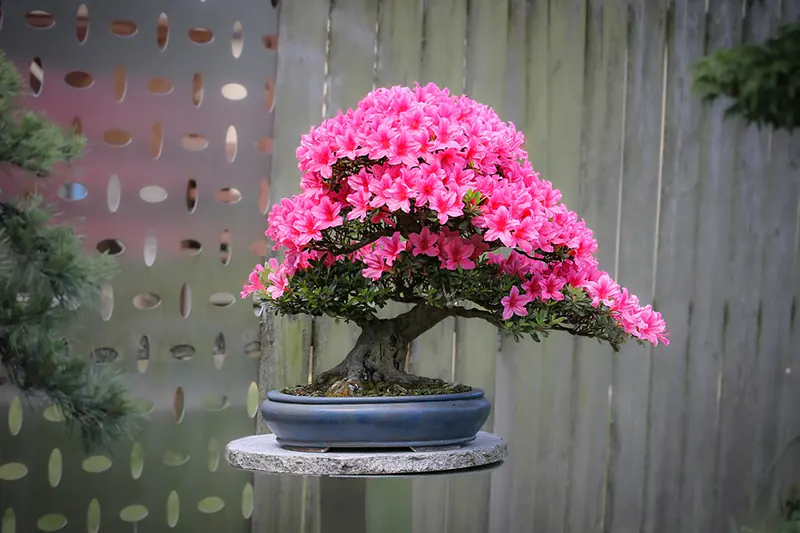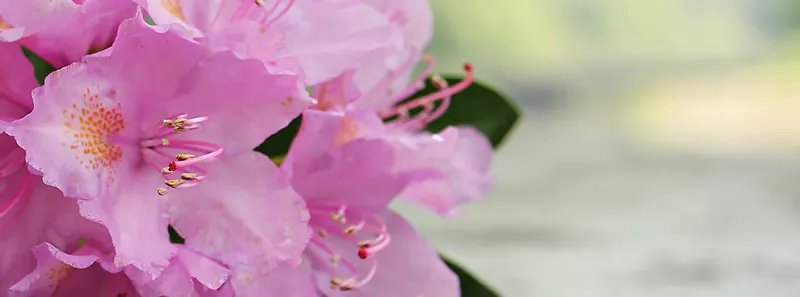How To Care For A Satsuki Azalea Bonsai
Satsuki Azalea is one of the cultivars of the species Rhododendron indicum, and isn’t a specific subspecies. It’s native to Japan, but its popularity has caused it to reach many countries worldwide. The name is derived from the Asian lunar calendar, and it refers to when the tree blooms.
Owning a Satsuki Azalea bonsai is a marvelous experience. As a matter of fact, it’s one of the most popular trees to grow in miniature form due to the gorgeous flower. Here’s an extensive guide on how to care for it.

What is a Satsuki Azalea Bonsai?
The term Satsuki is in reference to the Asian lunar calendar, in particular, to the fifth month. The Japanese gave it that name due to the beautiful flowers that appear at that time. It still belongs to the Azalea species Rhododendron indicum, but it’s a specific cultivar developed in Asia.
Since it’s so gorgeous and grows well as a bonsai, many enthusiasts have developed a few variants of Satsuki Azalea. Some examples include hinzan, gyoten, kaho, eikan, osakasuki, nikko, and more. They all have specific traits, but most of the unique properties relate to the flowers and colors.

Steps to Care for a Satsuki Azalea Bonsai
Now that you know a bit more about Satsuki Azalea, here are the steps towards caring for it as a bonsai. You can also check our ultimate care guide for Azalea bonsai trees in general.
Step 1: The Right Pot and Soil
All Azaleas love acidic soil, and Satsuki is no different. You’ll want to add some peat to the soil if the pH level isn’t right. You should also add some drainage stones at the bottom so that the water escapes quickly, as the bonsai doesn’t like wet roots.
Since the Satsuki Azalea bonsai has small, fibrous roots, you should aim for a wide, shallow bonsai pot. It doesn’t usually develop tap roots that grow deep, but even then, it will usually drink from the surrounding soil. A shallow container will also help you maintain healthy roots without outgrowing the soil, but make sure it’s as wide as the foliage.
Step 2: Placing in the Best Location
Most Azaleas enjoy full sunlight for a few hours in the day, but the Satsuki prefers some dappled shade. Look for a location where the sun catches it in the morning until peak afternoon. Your house wall or an overhanging net will help with shade for the rest of the day.
The sunlight also has a detrimental effect on the flowers. You’ll notice the petals fade, with the flower having a shorter lifespan than usual. In the winter, make sure your Satsuki Azalea bonsai has protection from frost, heavy rain, storms, and strong winds.
Step 3: Water and Food Requirements
Satsuki Azalea is a thirsty bonsai in the spring and summer. You’ll need to drench the soil daily to ensure that the roots have enough water to drink. However, make sure the liquid drains fast, as the roots don’t like remaining in soggy soil for too long. You can test the soil with your finger to see when it’s dry. Reduce watering in autumn and winter as needed.
When you want to feed the Satsuki Azalea bonsai, provide liquid fertilizer every second week in spring and summer until you see the flowers appear. You can also use a slow-release fertilizer if you’d like to let it seep into the soil slowly. Don’t feed it in winter, as that’s the tree’s resting period.
Step 4: Maintaining your Satsuki Azalea Bonsai
We’re sure you’ll want to train your bonsai to look stunning. Since the branches are brittle, you shouldn’t use wiring since it may break the stems. We recommend you use the clip-and-grow technique, as it will make the foliage richer. If you want to use wire, select aluminum instead of copper since it’s softer.
It’s not a good idea to do any hard pruning in spring. If you do, there’s a lower chance of flowers appearing in spring. Wait until the blooming period is over before you remove any leaves and perform maintenance on your bonsai.
Step 5: Repotting Every Few Years
While the Satsuki Azalea has small roots, they tend to grow vigorously in the younger years of the bonsai’s life. You’ll need to repot your small tree every two to three years until it becomes mature. You’ll notice the roots don’t grow as much and quickly, so you can stretch it out to four years later in its life.
We recommend you repot your Satsuki Azalea bonsai in early autumn. The flowers tend to soak most of the nutrients in spring and summer, and transplanting at that time causes unnecessary stress. Be sure to clear the old soil as much as possible and prune some of the longer roots.

Popular Bonsai Styles for Satsuki Azalea
What we love about the Satsuki Azalea is that its main purpose is to be grown as a bonsai. The stunning flowers stand out among the bonsai crown in any home, and you’ll usually find them in a bonsai nursery or garden. Here are some styles we recommend cultivating.
Formal Upright
This is probably one of the most popular styles for Azaleas. It involves letting the trunk grow directly straight up so the apex is in line with the base at the soil level. Of course, you can have some branches spreading out at the top or in tiers along the way.
Formal upright is ideal for Satsuki Azalea when you want your bonsai to have an even spread of flowers in an organized fashion. Showcase the blooms on slender stems on different levels or have them together at the top.
Canopy / Broom
The canopy or broom style is a subset of formal upright. The premise is that you have several branches at the top spreading out in all directions, making the foliage dense with leaves. Some people use a dome to cover the top when pruning to make sure the structure remains in place.
You can imagine how well the Satsuki Azalea does with a broom style. There are no branches on the lower part of the trunk, which means all the flowers are at the top. It makes a stunning floral display that’s hard to match with other species.
Informal Upright
If you take the formal upright and tilt the trunk offline from the base, you have an informal upright. You’ll find examples of this in the wild when trees don’t grow properly, especially when there are strong winds or disturbances during development.
When the Satsuki Azalea takes on an informal upright style, it’s a rare approach you don’t usually find among bonsai owners. Since the small tree will naturally want to grow upwards, you may need to convince it with wires or weights to shift direction. You can also remove the upper part of the main trunk and leave one of the side branches to take its place.
Windswept / Slanting
The windswept or slanting style is a subset of the informal upright form. What you’re trying to do is mimic a tree in the wild that’s slightly leaning over due to many years in the wind. You may even be inspired by a tree overhanging a massive cliff.
Since Satsuki Azaleas have soft branches, they usually sway in the wind than lean over. Still, you can leave the trunk to harden and develop in a slanting position if you want to show off your flowers in a different way than is traditionally used.
Root-Over-Rock
With root-over-rock, you can put those exposed roots to good use. The idea is to plant a small stone or rock formation under the base of the tree and let the roots grow around it into the soil. The challenge is that not all bonsai species enjoy this style.
For the Satsuki Azalea bonsai, you’ll have little or no issue. The small, fibrous roots are ideal for spreading over rocks and planting in the soil around them. We recommend waiting a few years until you need to transplant the tree. Carefully place the roots around a rock instead of pruning them.
Cascading
The cascade bonsai style works wonderfully on conifers like the Juniper genus. There are two subsets, both of which rely on the branch or trunk bending over the side of the pot. Full cascading is where the tip extends past the pot’s base, while semi-cascading bends back up before then.
You need to keep in mind that Satsuki Azaleas have soft branches and don’t take to wires well. Wiring or weights are needed to bend the trunk over and keep it in place. While it’s possible for this bonsai, you’ll need to use a semi-hardwood piece that’s less likely to snap.
Styles Not Recommended
While the styles mentioned above work well with Satsuki Azalea bonsais, there are a few that won’t. For example, stay away from bonsai forests, as the foliage needs space to spread if you want a decent display of flowers.
You should also not attempt a literati bonsai, as the style is too wild and may cause severe damage to your tree. While you can use a deadwood bonsai style by attaching it to a piece of driftwood, we don’t believe it complements the Azalea. In fact, it does the opposite.

Top Questions for the Satsuki Azalea Bonsai
With the bonsai being so popular, there are many questions about the cultivar that we’ve found online and in our emails. We’ve selected the top ones we haven’t covered as yet to make sure you have a definitive guide to care for your Satsuki Azalea.
Can Satsuki Azalea Bonsai Be Kept Indoors?
The only time you should keep a Satsuki Azalea indoors is when it’s winter and too cold outside. In spring and summer, it won’t do too well with limited sunlight and too much shade. Also, it prefers the fresh air it will receive outside.
If you’re determined to keep it inside your home, we recommend placing it near a window that supplies as much direct sunlight as possible. It will still need dappled shade during the hottest part of the day, but that doesn’t mean it will do well in low-light conditions.
How Long Does an Azalea Bonsai Last?
Your Satsuki Azalea should last you more than 50 years if you follow the guidelines we’ve provided. They live for more than 100 years in the wild, and you can also accomplish it with your bonsai. It’s a lifelong companion that just needs some tender care and love. Make sure it receives all the food and water it needs.
Do Azaleas Make Good Bonsai Trees?
When it comes to hybrid bonsai trees, the Kurume and Satsuki Azaleas are your best choices. After pruning your small tree, new leaves will form in that spot that makes it look like a cluster. It’s so easy to train, and the branches work well with ratification.
Many people overlook Azaleas in the store, as they see them as houseplants or trees that belong in the garden. Instead, you can place them in bonsai pots and train them to develop stunning foliage and flowers. It may drop some leaves from stress in the beginning, but it won’t be long before you see new buds develop over time.
Do yourself a favor and search for images of the Satsuki Azalea bonsai on the internet or Instagram. They’ll inspire you to head out and grow your own one for many years to come.
How Fast Do Satsuki Azaleas Grow?
In nature, the Satsuki Azalea can grow about six feet in height after 15 years. It’s a slow-growing tree where the leaves form as mounds on the branches. It takes long before it forms a new stem to hold foliage, and only under the right conditions.
As a bonsai, you can expect to see some decent growth in spring and summer. The more branches you have, the more leaves you’ll see spring into life. However, don’t expect it to gain more height within that season. It prefers to focus on the foliage and flowers than reaching for the skies. That’s why many people see the Azalea as a bush and not a tree.
How Big Does A Satsuki Azalea Get?
Left alone in the wild, a Satsuki Azalea will only grow to a height of about 4 feet. It loves remaining low, which is another reason people call it a bush. The species prefers to send its branches out to the side, which is why it’s usually 1.5 times wider than the height.
Your bonsai will only grow as tall as you let it. Since it’s a slow and low grower, you shouldn’t expect it to be a tall bonsai. Focus more on spreading the foliage out on either side to maximize the bloom in spring.
Do Satsuki Azalea Bonsai Go Dormant?
While most Azaleas are deciduous, the same can’t be said for the Satsuki cultivar. You’ll enjoy green leaves all year long, as long as the temperature doesn’t drop too low. Still, the bonsai will go dormant during winter so that it can rest before spring arrives.
If you’re losing leaves on your Satsuki Azalea bonsai, something is wrong. Besides cold temperatures, you may want to check for any pests or diseases. Another reason could be that you have it inside your home in a location where there’s insufficient sunlight. Try moving it outside for a few hours in the sun.

Are You Ready To Care For Your Satsuki Azalea Bonsai?
As you can see, caring for your Satsuki Azalea as a bonsai is relatively easy. You won’t need to take extra measures just to ensure that it thrives. Give it the right treatment, and it will keep you company for the rest of your life.
When you buy one at the store, just make sure you have the right cultivar. They may tell you it’s a Satsuki, but it may be something else completely different. Do your homework so that no one sells you an overpriced variant you didn’t want.







